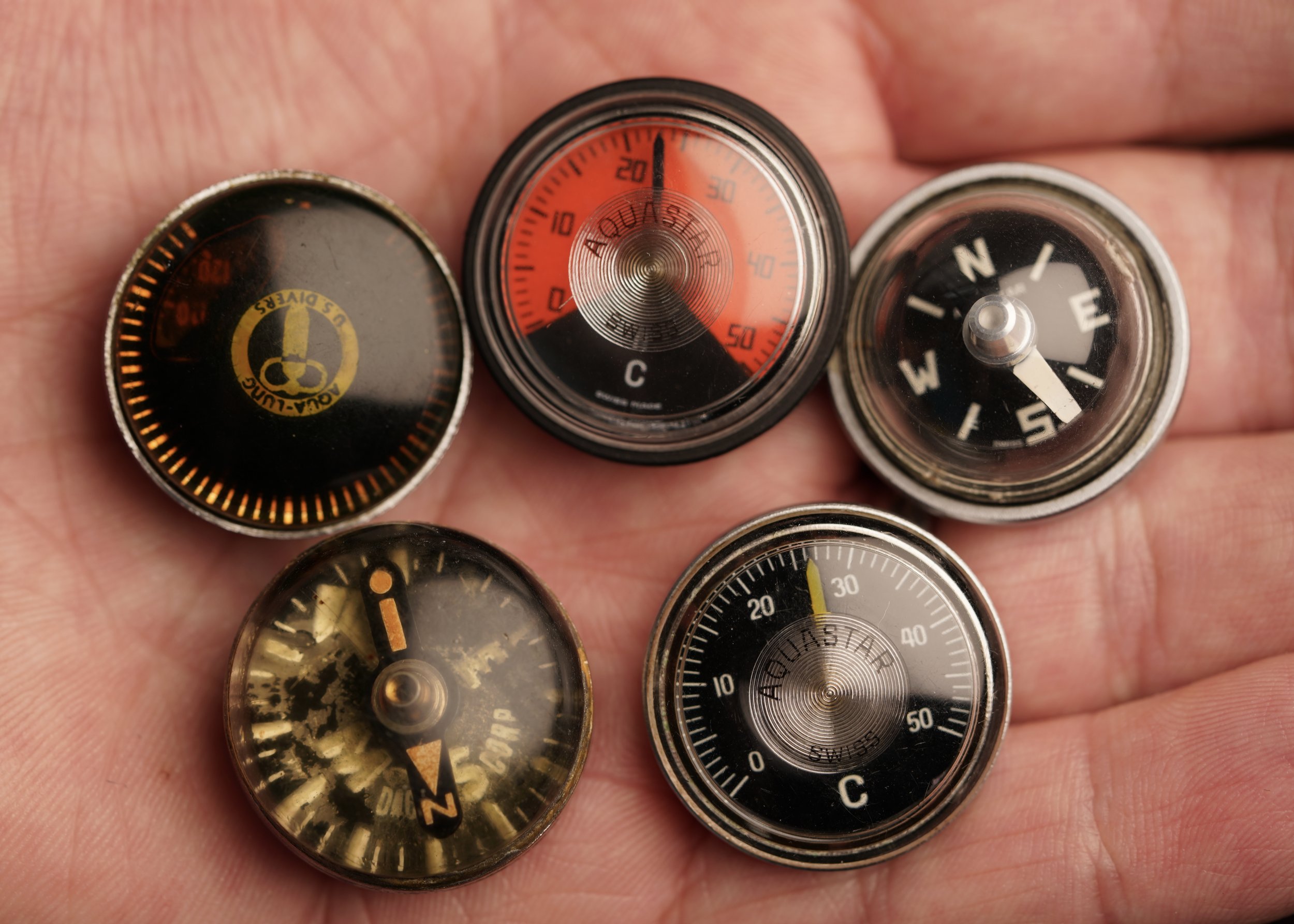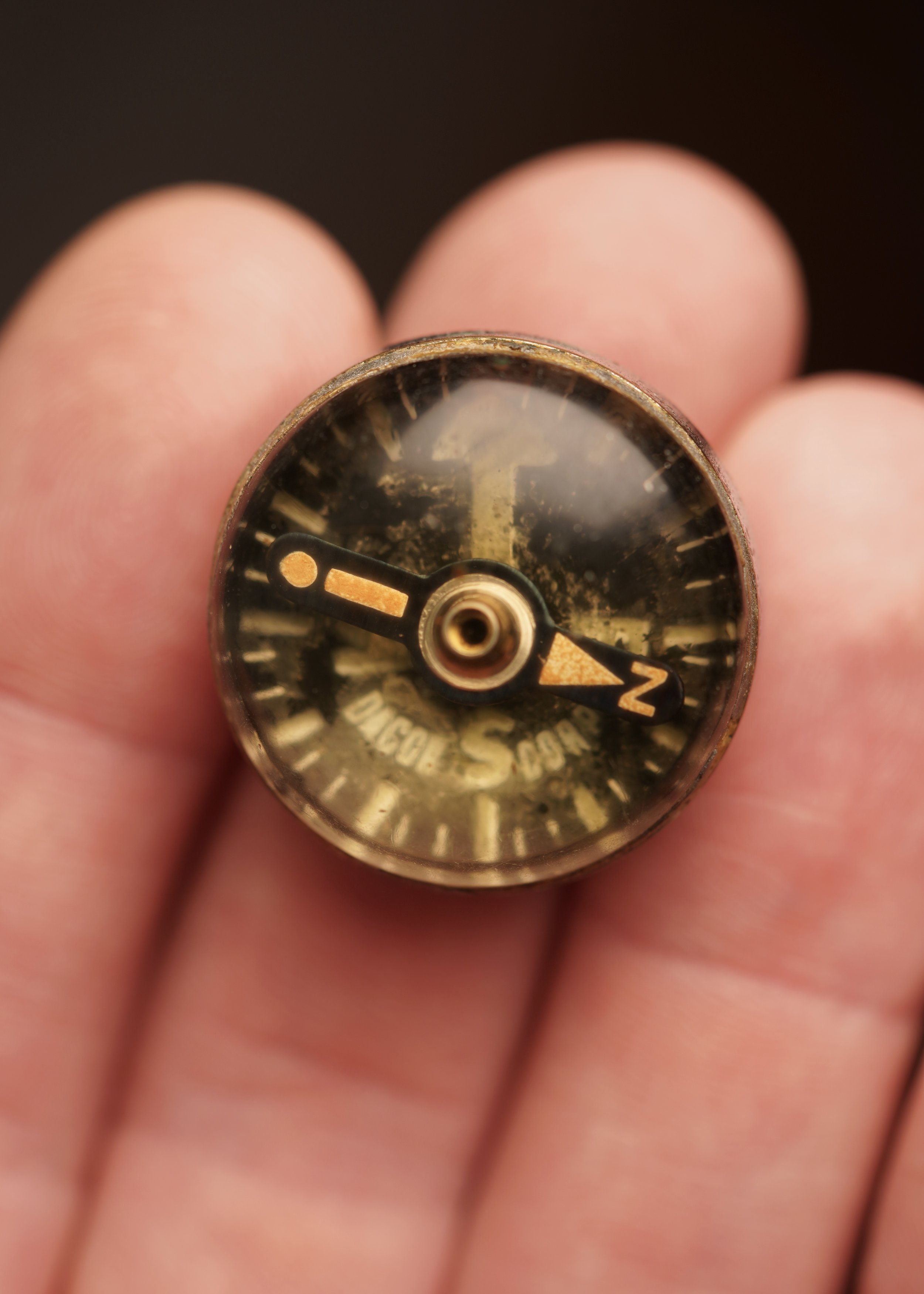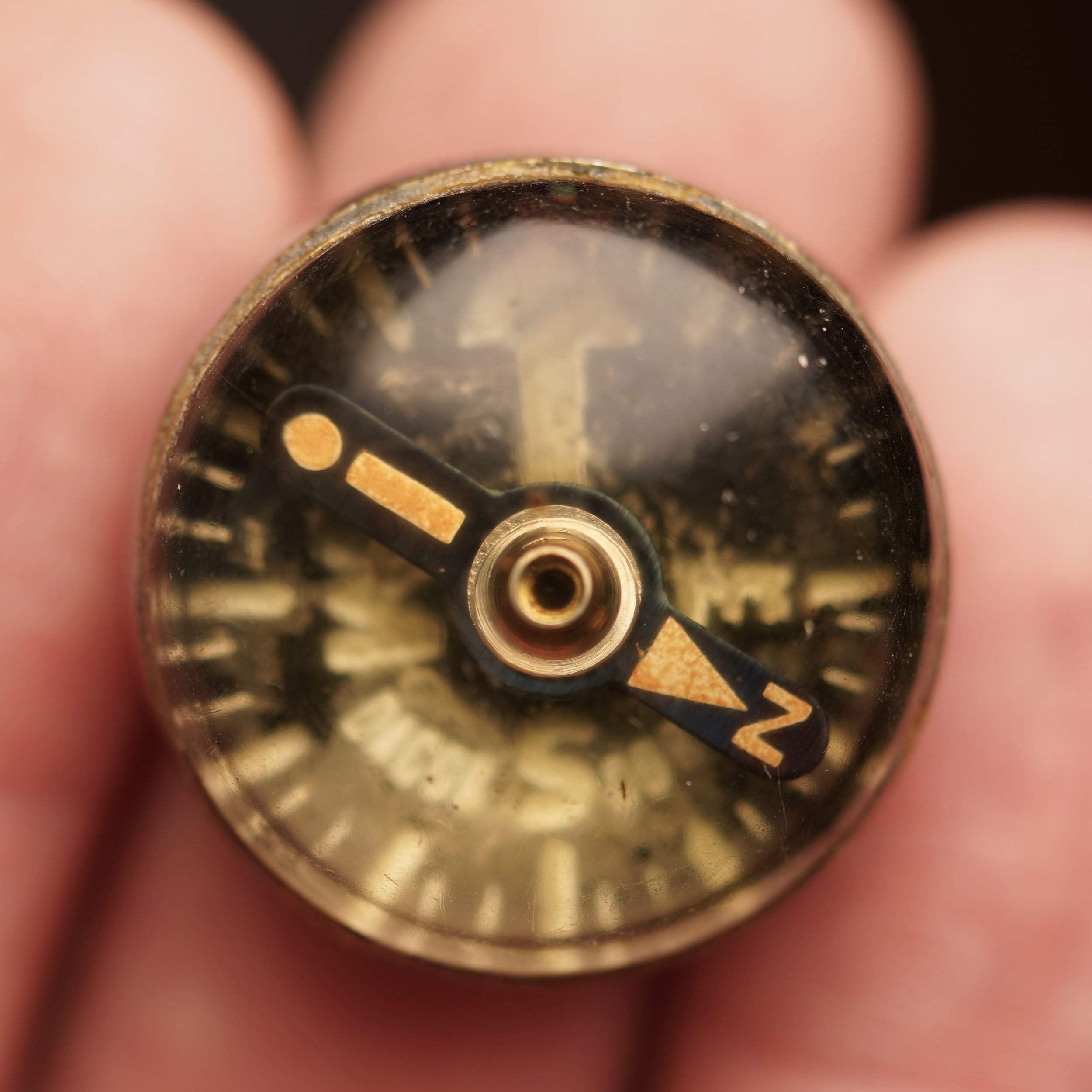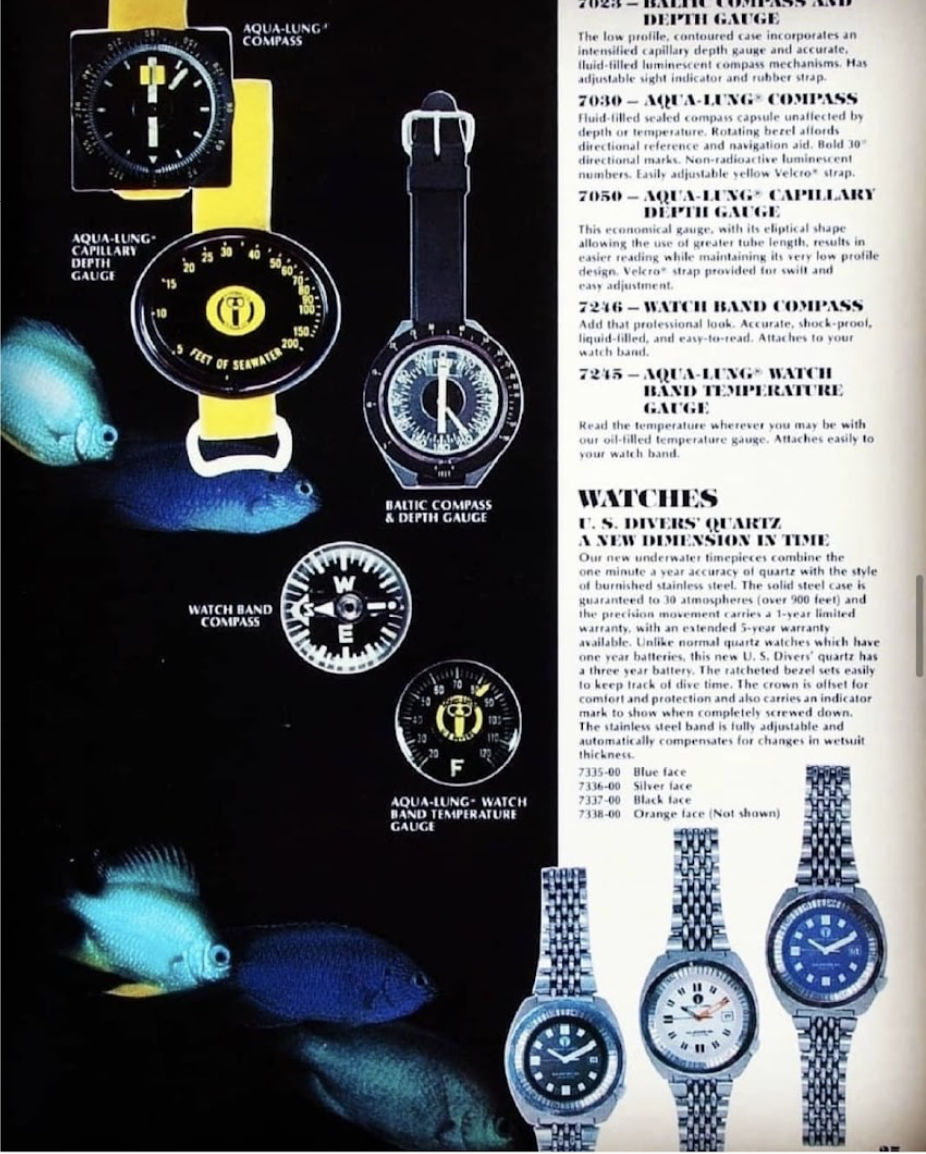Collector's Guide: Vintage Dive Gauges
By Scott Sawaya (@10thwatch)
Editor’s Note: We rarely feature guests on the Wind Vintage Blog, unless we are big fans of the individual. This article is written by Scott Sawaya (@10thwatch on Instagram). Scott is an outstanding collector and individual, who is one of the most knowledgeable collectors on vintage dive ephemera. You can learn more about Scott by visiting his new website https://www.10thwatch.com
Lorenz by Aquastar
Mid-century dive gear were integral tools illustrating the thin line between a diver’s safety and peril. There are few tools equipped on sports watches as fascinating as the elusive mid-century dive gear. Very little information has been written for watch enthusiasts on this subject until now. Whether you’re a watch collector exploring the this foreign topic or a diver looking to revisit past tools of the trade, this article will serve as your guide to the incredible ephemera of the past. We expect you will spend future nights searching for some incredibly special horological accoutrements for your vintage dive watch.
Lorenz by Aquastar
The Different Types of Vintage Dive Gauges
Dive gauges have been around since the early 20th century and have been used by divers all over the world. They are an essential part of a diver’s equipment. These gauges come in a variety of shapes and sizes and have specific functionality, each designed to measure different parameters of a dive.
Historically, divers have used a variety of gauges during underwater recreation or exploration. Early examples of these gauges were made of brass or copper and featured a range of dials and indicators to measure different parameters, depending on the type of gauge.
Variety of vintage gauges.
Vintage Aqua-Lung Fahrenheit thermometer pictured on vintage Tudor Submariner.
Later dive gauges that we will focus on (from the 1960s, 1970s, and 1980s) were made of steel, plastic, and rubber. These gauges possessed a wide range of dials and indicators. From what we know, the most common type of dive gauge used by divers like Jacques Cousteau, was the depth gauge. These gauges were used to measure the depth of a dive and featured a dial that displayed the diver’s current depth in feet or meters.
Another popular type of vintage dive gauge included thermometers, which were used to measure the temperature of the water. Vintage thermometers can be found in Celsius or Fahrenheit and in a variety of colors and brands. From my research and collection spanning over 5 years, those thermometers measured in Celsius are rearer to the Fahrenheit variety.
Compasses also came in the smaller “button” gauge formfactor, which, as expected, measured the direction of the dive. Overall, the compass gauge, that is, those fitting on the tail of a rubber Tropic dive watch strap, have proven to be the rarest of all types of vintage gauge in this format.
Gauge Design
Vintage dive gauges were designed to provide accurate and reliable readings to divers. As noted, features typically included a dial that displayed the current depth of the dive, the temperature, and directional data.
The materials used to make these gauges often varied. Some were made of steel that were nickel plated, several were made of plastic, and some of the later, 1970s-1980s button gauges had backs made of rubber. Ocean Dynamics was one of these later manufacturers that had backs all made of rubber.
Most of the gauges, though, featured similar crystals or plexiglass that covered the dial.
The backs of the gauges where they attached to a dive watch or larger depth gauges strap came in two varieties. The first was an open loop where the Tropic or nylon dive strap would slip through the back of the gauge.
The back of an Aquastar thermometer.
The second most common backing was what could be described as a two-prong catch that would also allow the diver to slip the gauge right through the back to connect it to the strap. This two-prong back was not connected and was likely less secure than the full looped version.
The back of an Aqua-Lung thermometer.
An Ultra-rare Aquastar orange dial Celsius thermometer with black plastic backing.
I haven’t seen consistency in which gauge used what method for the backs, but brands such as Aquastar and Aqua-Lung were consistent in the style and attachment their gauges had.
Many of the gauges that were completely made of plastic - mostly all black, have a complete loop (as opposed to the two-pronged) backing. I suspect this was done to ensure integrity and strength or security of the gauge as it was attached to the strap.
The dials of the various types of gauges were minimalist for clarity and easy reading. Most of these smaller strap gauges were no more than 26mm in total size whereas the dial was closer to 22mm so only necessary content was included on the dial. A lot of the gauge dials we see from the 1960s and 1970s are black and have white contrasting numerals and hashing with a yellow, orange, or red indicator hand. There are some less common gauges featuring blue and orange dials that have become some of the most sought-after varieties.
Double stamped Aquastar + Scubapro blue dialed Fahrenheit thermometer with black plastic backing.
An ultra-rare Aquastar orange dial Celsius thermometer with black plastic housing.
Another structural spec on these gauges is that many were filled with an oil for them to manage decompression. I’ve read on various forums and vintage catalogs that the liquid was glycerine. Some modern divers looking to clean and refill their gauges have used brake fluid or even a clear mineral or baby oil. The gauges without oil seem to have held up the best over time. That is, the dial and indication is clearer and less seems to be less susceptible to deterioration.
Screw Pins
Some gauges had a screw pin that would thread into the back of the gauge for securing to the Tropic strap of a dive watch or larger wrist gauge. A pin would've only come on a gauge with a back that was an open loop. That back flat piece where the Tropic or nato would pass through the gauge had a small threaded pinhole. Screws were easily separated from gauges and many were lost. It’s rare to find a therm or compass with its original pin. But the great news is, the pin is unnecessary and the gauge can be secured on a strap without it. There does not seem to be any overwhelming consistency on gauges that did or did not design a back requiring a pin. However, a pin was never used on a plastic backed gauge.
The back of an Aquastar thermometer with the original screw pin.
Hose Adapter
I thought these “button” sized dive gauges were made for watches, depth gauge, and compass straps only! But alas - there were two other vehicles in which they traveled. One was a small plastic adapter that came with one of my gauges that would have affixed to the rubber hose that ran from one of the tanks to the console.
Black plastic hose adapter pictured with Dacor Fahrenheit thermometer.
From a self-proclaimed “old salty” IG user @eddyvonraff gave some insight as to how and where this gauge would’ve made sense on a dive. “After the reserve valve and before the consoles, the novelty was the submersible pressure gauge, this was connected to the HP outlet of the regulator 1st stage and the hose could be a tad narrower as the LP hose to the 2nd stage. Time for creative solutions, it makes me soft to see this is a novel adapter to an otherwise watch strap devised gauge! There must be a clip though, to keep the assembly together, that snaps into the recessed area!”
The second way a “button” gauge may have been used was in the actual dive console itself.
Collecting Vintage Dive Gauges
Collecting vintage dive gauges can be as rewarding and enjoyable as watch collecting. I have met some incredible people in the watch community because of my gauge collection and posts on vintage dive gauges! Like watches, it’s a great way to connect with the history of diving, as well as to enjoy the beauty of these unique pieces of equipment that in some cases, were made by the very manufacturer of the watches we love! I have learned as much from researching these gauges as I have from collecting vintage watches.
Dive Gauge Brands
When it comes to vintage dive gauges, there are a few brands and manufacturers that stand out. Aquastar, Scubapro, Dacor, and Aqua-Lung are 4 of the most popular brands and manufacturers of the “button” gauge.
Aquastar
By and large, Aquastar is the most common brand of vintage “button” dive gauges I have seen through the years. They come in many variations. The most common version we see is the Fahrenheit thermometer with a black dial, a steel case, and without any liquid or oil fill. Aquastar made several variants of their thermometer. They made a version with a blue dial and another with an orange dial in both Celsius and Fahrenheit. These colored dials are highly sought after and unique in the world of these small gauges. The most unique one being the orange dial Celsuis version with a black plastic case. Another rare bird is the Celsius black dial, oil-filled, with a steel case. This particular variant had a screw on the top of the plexiglass dome. Some in the diving community speculate that the screw covers a liquid refill inlet where you could clean out or replace the liquid if ever required.
Most Aquastar Fahrenheit therms scale from 32° to 120° indicated on the dial. There are two other less common variants; the first scales from 10° to 120° and the second variant starts at 0° and scales to 120°. The latter is shown for sale via the Healthways catalog retailing for $3.95 in the 1960s.
A rare oil-filled Aquastar Celsius thermometer with what appears to be an original teal Aquastar price tag.
The Aquastar compass is one of the rarest and most coveted “button” gauges. I have only seen about a dozen examples in person and online. Although I have seen catalog images where the compass was filled with glycerine or another oil to help with pressurization, every example I have owned or seen in an online collection has been the version without oil. There are four known variations of the Aquastar compass - all of which have a bubble type plexiglass cover to accommodate the tall compass pin and with steel or black plastic backs. One of the variants has “Aquastar'' near the bottom on the dial and the second version had “Aquastar” at the top of the compass above the pin indicator and below North.
Another version of the Aquastar compass which was included in “The Navigator”. “The Navigator” was a set of gauges that included a full-sized depth gauge, a thermometer, a compass, and a dive watch that were fixed all on one single plastic panel that a diver would wear on their wrist. The compass included had a wide bezel which I suspect was used to secure it to the panel. As the fifth “app”, “The Navigator” had a waterproofed slide out card decompression table!
“The Navigator” pictured in a 1962 Healthways catalog.
The last variant of the Aquastar compass known to me has a white and black painted pin, is housed in black plastic, and has very narrow letters to represent north, south, east, and west. It has “Swiss made” split on either ride of the “S” at the bottom of the compass. I have only ever recorded one example of this type.
Scubapro
Scubapro retailed Aquastar products and likely used the same manufacturer for their thermometers. I say that because they are identical in shape, size, style, and material. Scubapro did not offer a “button” compass with their name on the dial. Scubapro thermometers had many variants. The most common was a Fahrenheit steel cased thermometer with a black dial and without fluid. They also had a blue dial gauge with a steel or a black plastic backing and another version of the steel backed black dial that also had the screw on the top of the plexiglass dome as pictured.
Aquastar and Scubapro had a variety of cobranded thermometers. Some had a vivid blue dial with a black plastic case but most were the traditional black dial with steel cases. One common trait was that they were all measured in Fahrenheit. I have yet to find an Aquastar + Scubapro thermometer in Celsius. That likely speaks to Scubapro as an outfitter and retailer being founded and based in the US in 1963.
Dacor
Dacor, a dive outfitter based in Illinois, US, made compasses, thermometers, and capillary gauges in the “button” format. The compass was always oil filled. The thermometer came in both Celsius and Fahrenheit and was also always oil filled. Although, I have only ever seen one Celsius therm in person. I would guess they were less prevalent only based on the fact that Dacor was a domestic dive equipment brand.
Dacor magazine ad circa 1978 with all five varieties of their “button” gauges.
Dacor made an extremely unique capillary “button” gauge in both metric and standard. I’ve only seen three examples of this gauge and all in “feet”, two of which I have owned. The gauge provides a close measure of depth during a dive. I can’t explain how it works better than the scuba dive G.O.A.T himself, Alec Pierce, in his Vintage Scuba YouTube series episode SO2E13. They’re one of my favorite gauges because of its complexity and uniqueness. It’s the only example of a depth gauge in “button” format that I have ever found.
Aqua-Lung
The Aqua-Lung made both thermometers and compasses for dive straps, although we have never seen an Aqua-Lung compass in the metal. The Aqua-Lung thermometer is an all-time favorite amongst the hard core, former divers, and collectors in the watch community. Aqua-Lung therms came in Celsius and Fahrenheit, were always originally oil filled, and had the plexi crystal and steel back. I have never seen a Celsius version of the therm but we know it existed and several divers and collectors have confirmed this. There is a certain charm to an Aqua-Lung therm. The dome is slightly lower profile than most dive gauges and the oil reflects back carefully magnifying the numerals and hashmarks on the dial. They are extremely well made and even have a bit of unexpected-for-how-small-it-is heft that comes with it. From a current value standpoint, we’ve seen Aqua-Lung thermometers sell privately and via eBay higher on average than any other brand. It would be fascinating to see what a Celsius variant might fetch!
The Leftovers
There were several other “unbranded” or “sterile” thermometers to come out of the vintage dive era. I’ve seen varying designs but the most common is an almost rainbowed outer edge with a black dial. There were several different styles including steel or black plastic cases. One of the most unique unbranded thermometers we’ve seen has only a sea turtle on the plexiglass and is stamped “Japan” on the back.
Modern Gauges
There are several companies that made gauges through the 1980s and through today. Ocean Dynamics, one of those manufacturers - likely made dive gear in the 1970s-90s. Not much is known or written about the history of Ocean Dynamics but their gauges were common accessories in US dive shops. OD gauges were often made with the same plexi cover but had a black rubbery-plastic backing.
Ocean Dynamics dive gauges including a compass and Fahrenheit “rainbow” thermometer.
Another modern maker and brand is Ever-Trust. Ever-Trust has a simple compass strap gauge housed in black plastic with variations of a light or white colored dial. These are mostly used or marketed for camping, hiking, and other outdoor recreation.
Revived watch companies like Marathon, Benrus, and Aquastar have their take on the strap gauge and have paired them with reissued dive watches. Through a quick Google search, you will be able to find these and some additional modern brands and examples.
Gauge Sizes
Aquastar - steel and nickel plated therm (all varieties including Scubapro cobrand) - 26mm with 20mm opening for strap
Dacor steel and nickel therm - 26.5mm with 20mm opening
Dacor compass - 26mm with 20mm opening
Dacor depth gauge - 27mm with 20.5mm opening
Aqua Lung therm - 26mm with 19.5mm opening
Ocean Dynamics therm and compass - 29mm with 20.5mm opening
Rainbow dial steel and nickel therm - 26.5mm with 20mm opening
Advertisements and Dive Catalogs
Aquastar ad from early to mid-1960s showing the complete dive watch lineup including “The Navigator” wrist panel.
Vintage advertisements and dive catalogs have been an invaluable way to learn more about dive gauges. Vintage ads have become a popular way to display original imagery showing off what it would have been like to see vintage pieces set in their original era. Dive gauges are no different. As you might have guessed, dive gauge ads are rarer and unsurprisingly, seem to always be pictured with a vintage watch and other various pieces of dive equipment. Catalogs are also an excellent source to see and learn about dive gauges. For instance, Healthways, a sporting goods company, offered a complete inventory of dive equipment. As legend has it, Healthways was the first company to use “scuba” as a word rather than an acronym. Their catalogs listed dive watches and gauges for sale from a variety of brands.
Image credit: @titus_calypso.
Vintage Scubapro ad. The center picture on the bottom row shows an Aquastar 63 watch on what appears to be a special wide leather cuff which accommodates an Aquastar compass on the bottom and a thermometer above the watch head.
Original 1960s Aquastar pamphlet showing several gauges including a full sized depth gauge and compass. A Celsius “button” gauge and a small strap compass are also pictured.
Early Aquastar ad picturing a Celsius “button” gauge on a JeanRichard diver. This ad shows the reference number 3010 (Celsius) 3020 (Fahrenheit) associated with the gauge.
Image credit: @vintagewatchadverts.
Original 1970s Aqua-Lung catalog showing several gauges including a full sized depth gauge and compass. A Fahrenheit “button” gauge and a small strap compass are also pictured.
Original 1960s Dacor ad from a magazine with the depth “button” gauge measured in feet, reference WGC pictured on a Dacor dive watch.
Original Healthways skin and scuba diving equipment catalog circa 1960s.
Pictured inside the Healthways catalog is a Fahrenheit “button” gauge on a JeanRichard diver and the original price.
In the Field
In this final section, we’ll take a look at the various places we have seen dive gauges in the real world. The vast majority of vintage dive gauges we see are those of the full size variety. Through our research, we see that these smaller strap gauges were mostly used as add-ons. Most divers had other, larger gauges or instruments to measure environmental parameters. The gauges you’ll read about here were rarer to see in movies, documentaries, or photos. Below we share the few instances found.
In a scene (26:34) from The Undersea World of Jacques Cousteau - South to Fire and Ice, we see a very practical use of an Aqua-Lung Fahrenheit thermometer being placed in the water's surface to check the temperature where steam is rising. The water is above the maximum display temperature of 120°.
The next field spotting takes us to the 1960s and just off the coast of California to SEALAB. SEALAB was a US Navy experiment centered on underwater habitats. In SEALAB: Chapter 1 on PBS’s American Experience, we find a strap thermometer attached to the Rolex Submariner of astronaut turned aquanaut, Scott Carpenter.
https://www.pbs.org/wgbh/americanexperience/features/sealab-chapter-1/ - clip starts at 00:00:40]
Additional images of SEALAB Aquanauts with various dive gauges. Images courtesy of the U.S. Naval Undersea Museum.
“Berry Cannon (left) was wearing a Blancpain Fifty Fathoms Mil-Spec. Carpenter wearing a Rolex Submariner 5512.” Source Perezcope (SEALAB 2 – ROLEX SUBMARINERS).
In Justin Couture’s (@ wristorian) 2022 article on The Lesser-Known Dive Watches of SEALAB II - he includes several images of SEALAB Aquanauts wearing dive gauges on the straps of their watches. Images courtesy of the U.S. Naval Undersea Museum.
Vintage dive gauges are becoming just as sought after as the vintage dive watches they accompanied and it makes sense. The idea that the very watches we love, made by the brands we love, manufactured these fine supplemental tools and instruments is fascinating!
I can recall the first time I saw a vintage dive gauge. It was 2018 when I purchased my first Aquastar 63. The watch was flawless - original Tropic basketweave rubber strap and JeanRichard anvil buckle. And there it was, something I had never seen before, strapped onto the long tail of the black rubber strap - a thermometer. It was so cool and when I looked closer, I saw “Aquastar'' written on the dial. It hit me right then, Aquastar made thermometers for their dive watches - “Swiss Made” and all!
I never looked back. I immediately started Googling which has led me to countless hours (now years!) of reading, research, and Instagram DMs. I hope this article has been beneficial and even if vintage dive gauges aren’t your thing - there are so many opportunities to learn more about the world around the watches we love!































































